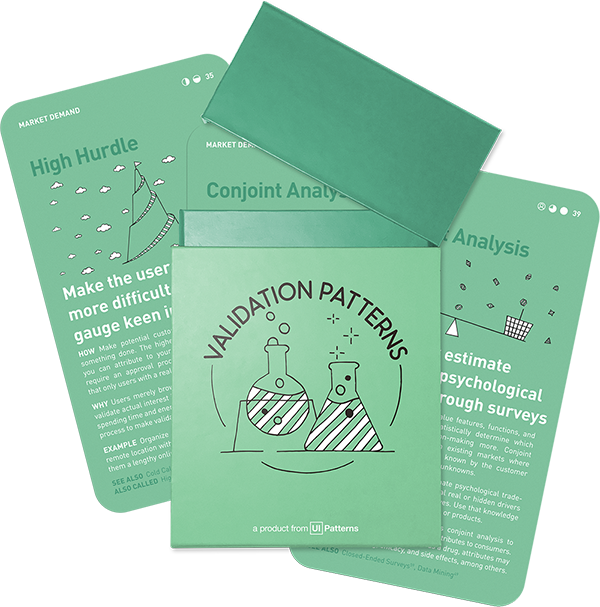See also: Contextual Inquiry, Find the Watering Hole
Difficulty: Hard
Requires existing audience or product
Evidence strength
Relevant metrics: Jobs to be done ranking, Ranking needs, wants, desires, pains, Quotes & stories, Observations
Validates: Desirability
How: Establish a customer partnership to your mutual benefit by allowing your team to relocate to customer premises while you are developing your product.
Why: By moving in with your customers, you get first-row access to understanding customer pains, context of use, stakeholders, underlying needs, and business reality. User testing can become as easy and accessible as an informal chat.
This experiment is part of the Validation Patterns printed card deck
A collection of 60 product experiments that will validate your idea in a matter of days, not months. They are regularly used by product builders at companies like Google, Facebook, Dropbox, and Amazon.
Get your deck!Before the experiment
The first thing to do when planning any kind of test or experiment, is to figure out what you want to test. To make critical assumptions explicit, fill out an experiment sheet as you prepare your test. We created a sample sheet for you to get started. Download the Experiment Sheet.
Truly understand the environment
“Move in With the Customer” is an effective strategy for product teams seeking a deeper connection with their customers. It enables the creation of products that are not just technically sound but also resonate with the target audience on a more personal level. By implementing this approach, product teams can foster innovation, enhance customer satisfaction, and gain a competitive edge in the market.
The core idea of this method is to go beyond traditional market research and develop a firsthand understanding of the customer experience. By physically being in the customer’s environment, whether it’s their home, workplace, or elsewhere, product teams can observe and interact with customers in their natural setting. This approach provides insights that might not be evident in controlled testing environments or through surveys.
This method allows teams to identify pain points and opportunities that might otherwise be overlooked. It also helps in building products that are more closely aligned with the actual needs and desires of the target audience.
Great for Business to Business (B2B)
A typical pain point for companies selling B2B products and services, is hard access to real users - or just observing what they do. Where the feedback loop of B2C products can often be measured in minutes, it can take months or years before a B2B enterprise customer decides to leave.
When building enterprise software, proximity to customers is key. By having one or more product teams stationed at client offices to report on customer pains, context of product use, stakeholders, the underlying needs, and of enterprise reality, it is possible to gain access to the information that can help drive your product forward.
By having teams stationed at different companies - either at the same time or in turn, you can take note of commonalities between customers, and eventually grow your product into a standardized offering.
Analyzing and applying insights
Post-immersion, collate and analyze the data collected. Look for patterns, unmet needs, and potential areas for improvement or innovation in your product. The insights should then be translated into actionable product development strategies.
The analysis and application of insights is not a one-time activity but a continuous part of the product development lifecycle. Regularly revisiting customer insights and adjusting strategies accordingly ensures that the product remains relevant and valuable to the customer.
After the experiment
To make sure you move forward, it is a good idea to systematically record your the insights you learned and what actions or decisions follow. We created a sample Learning Sheet, that will help you capture insights in the process of turning your product ideas successful. Download the Learning Sheet.
Examples
Coveo
Search startup Coveo moved small development teams to stay on site at clients’ offices until they were able to solve the customer’s problems, build custom integrations, take note of commonalities, and, eventually, build a standardized product.
Source: Coveo
Tesco
When the Britiss company entered the U.S. market in 2007, Tesco’s UK staff lived with 60 American families to understand their habits and preferences, discovering key differences in shopping behavior and preferences between Americans and Europeans. This deep immersion in the customer’s world allowed Tesco to tailor its product offerings and services effectively.
Source: ‘Outside In’ Strategy for the C-suite: Put Your Customers Ahead of Your Capabilities
Related plays
- How Moving in with Customers Can Help Speed up B2B Customer Discovery by Étienne Garbugli

